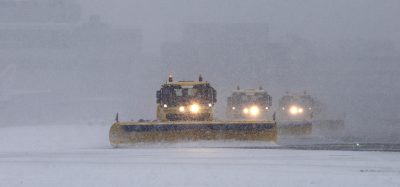Ready for the big freeze
- Like
- Digg
- Del
- Tumblr
- VKontakte
- Buffer
- Love This
- Odnoklassniki
- Meneame
- Blogger
- Amazon
- Yahoo Mail
- Gmail
- AOL
- Newsvine
- HackerNews
- Evernote
- MySpace
- Mail.ru
- Viadeo
- Line
- Comments
- Yummly
- SMS
- Viber
- Telegram
- Subscribe
- Skype
- Facebook Messenger
- Kakao
- LiveJournal
- Yammer
- Edgar
- Fintel
- Mix
- Instapaper
- Copy Link
Posted: 7 February 2012 | Jan Kadlec, Airfield Operations Manager, Prague Airport | No comments yet
Prague Airport is the biggest airport in the Czech Republic and one of the major hubs in Central and Eastern Europe. Prague’s excellent location in the heart of Europe together with its recognition as an attractive business and holiday destination represents a unique opportunity for air service development.
Like London and Frankfurt, Prague Airport suffered in the 2010/2011 winter season. However, the airport was only closed from 1-2 December 2010 for six hours. Over 100cm of snow had fallen between 26 November and 31 December. During those 36 days, 34 of them were spent maintaining runways and airport premises from the bad weather conditions. The biggest snow falls during last season were on the 28 November (12cm), 1 December (20cm) and 15 December (10cm). In all we had to use approximately 570,000 litres of de-icing fluid.
The main problem was the snow on the apron, a place where the airplanes are parked and handled.
Prague Airport is the biggest airport in the Czech Republic and one of the major hubs in Central and Eastern Europe. Prague’s excellent location in the heart of Europe together with its recognition as an attractive business and holiday destination represents a unique opportunity for air service development.
Like London and Frankfurt, Prague Airport suffered in the 2010/2011 winter season. However, the airport was only closed from 1-2 December 2010 for six hours. Over 100cm of snow had fallen between 26 November and 31 December. During those 36 days, 34 of them were spent maintaining runways and airport premises from the bad weather conditions. The biggest snow falls during last season were on the 28 November (12cm), 1 December (20cm) and 15 December (10cm). In all we had to use approximately 570,000 litres of de-icing fluid.
The main problem was the snow on the apron, a place where the airplanes are parked and handled.
The decision to close our runway was a relatively simple one, our ‘SNOWTAM’ message gave clear information on the snow that was laying such as deposits, depth and friction measurements. Working to this information it was obvious that the runway could not handle flight movements. The situation within the apron area was more difficult to monitor, there is not a clear rule to work from in this part of the site and it is down to each airport and what they consider to be ‘too much snow’. This was something that we needed to consider going into the current winter season.
Winter service maintenance concept
The winter time period officially starts on 1 November and ends on the 31 March, but the dates are always adapted to the weather conditions, so the winter may start two weeks earlier or end two weeks later, depending on the current situation.
Prague Airport has four working, winter service maintenance teams. One of them is outsourced by an external company, which is responsible for the landside maintenance. The other three teams are responsible for the airside maintenance. These three teams are; the ‘runway working group’, the ‘apron working group’ and the ‘gate working group’. The latter is relatively new and was established before November 2011 due to the problems experienced within the last winter season.
The ‘runway working group’ is responsible for clearing the snow and de-icing runways and taxiways. This group consists of 17 jet-sweepers, two snow-blowers and two sprayers for de-icing the pavement area. The ‘apron working group’, is responsible for snow clearing and de-icing of the aprons. Most of the equipment from the ‘runway working group’ such as the jet-sweepers and snow-blowers is shared amongst the other groups. Other equipment, such as snowploughs, loaders, trucks, sprayers and spreaders are assigned to this specific group. The most recent, the ‘gate working group’ is mainly responsible for the stand and boarding gate maintenance, which consists of smaller machines such as tractors.
Technology and procedures
Jet-sweepers are the main kind of snow clearing equipment that we use for winter service maintenance of the movement area. Winter maintenance of the area is managed by the use of a de-icing chemical surface treatment. The type of treatment for this area is dependent on the state of the site and the current weather situation and forecast.
Mechanical clearing
Advantages
● Mechanical clearing can lower the overall cleaning costs. Chemicals are more expensive than costs combining fuel consumption and material costs, especially brooms.
Disadvantages
● More time spent on the clearing of move – ment area. Clearing a runway can amount to 30 minutes compared with eight minutes when using a chemical treatment
● A substantially longer time period necessary to prepare the mechanical equipment
● Owing to the maximum usage of all jetsweepers there is no back-up or reserve in case of mechanical failure
● 100 per cent utilisation of available human resources meaning there is no personnel to deal with other affected areas
● High amortisation rate for a large proportion of the mechanical equipment.
Chemical clearing
Advantages
● Time-efficient clearing method
● Virtually no restrictions in respect to air traffic operations
● Mechanical equipment ready for immediate action at all times
● Only two to four machines necessary for the clearing operation
● Mechanical clearing may be applied simultaneously at other airport areas
● Lower fuel consumption and material costs.
Disadvantages
● Overall clearing costs higher
Beating the cold
At first glance, it seems that the advantages of chemical clearance will outweigh the benefits of mechanical clearing. This, however, is not neccesarily the case, both methods are essential for winter service and maintenance for the airfields.
The groups designed for clearing the runways, taxiways, aprons, gates and other non-public airport areas are established in accordance with the movement area clearing rules, procedures and preferences at Prague Airport.
The clearing of runways, taxiways and aprons in the ‘airside’ area is conducted with specialised, mechanical equipment such as the airport jet-sweeper and snow ploughs. These machines are supplemented with snow blowers and smaller pieces of equipment that are designed for the removal of snow from parking areas and from the vicinity of boarding bridges. Other activities within the ‘airside’ area include the clearing of perimeter roads and access roads for air traffic navigation services facilities and meteorological services.
For safety and security reasons, the operation of larger, specialised mechanical equipment such as sweeper, snow-ploughs, sprayers and spreaders in the airside area are operated only by the Airfield Operations employees who have sufficient experience within the operational area of the airport. Smaller equipment such as tractor ploughs, tractor sweepers and flatbed tracks that are designed for clearing snow from the vicinity of boarding bridges and removing snow from the aprons, are generally manned by other Prague Airport employees or by contracted external entities.
The winter season of 2010/2011 proved that with high snowfall intensities, it becomes impossible to clear a runway with clearance vehicles that simply move back and forth; this method is time consuming as well as limiting for runway operations. It is more likely that some runway areas will no longer be in workable conditions (with respect to sufficient braking action) after completing the second runway clearance. Thus forcing a runway closure for further clearing, again limiting traffic.
According to our rules and procedures, a runway clearing must be carried out with maintenance vehicles that move in one direction without any interruption, ensuring quick completion of the process and to restore runway traffic where braking action remains sufficient. In such a clearing scenario, only one entrance and one exit taxiway will be cleared at either end of the runway with traffic being restored immediately afterwards. All the other runway exits are then cleared afterwards in accordance to the technical capabilities and operational needs of the airport. In the case of heavy, long-term snowfall, where the rapid deterioration of braking action calls for the runway to be cleared in a short period of time, only the track and taxiways at both ends of the runway are cleared.
A total of 17 jet-sweepers are currently available at the airport, with four of them incorporating a broom width of 4.9m, including a working overlap of 50cm. The remaining 13 have a broom width of 2.9m, which provides for a total 57.3m. A higher layer of snow cover increases this working overlap, which means that it is possible to clear the full width of the runway at once with a minimum of 16 jet-sweepers. If fewer than 16 are available, the width of the cleared runway may be limited to no less than 30m. A similar procedure for clearing the runway must also be applied in cases where it is necessary to simultaneously carry out the clearing of stands on the main apron.
In order to prevent ice formation, liquid antiicing agents, approved for use at airports, are used in the movement area. Its ice removal is accomplished with the help of solid, pre-wetted de-icing chemicals. The chemical treatment of ‘landside’ (roads, parking lots) is sprinkled with technical salt, rock salt brine or carbide (urea), the latter is also used for the treating of pedestrian sidewalks. A combination of mechanical clearing machines and chemical usage is applied on both the ‘airside’ and ‘landside’ areas. Spraying the movement area with de-icing agents is performed after the machines have removed the snow in case of continuous snowfall and bad weather forecasts insufficient braking conditions on the runway.
Equipment
For our main winter service maintenance, we use jet-sweepers. There are four high-performance and wide-span, compact Jet Broom Runway units from Boschung, four compact P-21 units, four compact P-17 units and four tow-behind P-17 units from Zaug AG Eggiwil and one multifunction compact BJB 8000 unit from Boschung. In terms of snow-blowers, we use two KSF 170 M2 units and one KFS 950 / 2600 loading snow-blower unit from Kahlbacher, one Supra 5000 unit from Schmidt, one Rolba 4000 unit from Zaug AG Eggiwil and two older Schmidt 1500 units. For de-icing the pavement, we have two armed sprayer units each from Schmidt and from Epoke, one twin-disk sprayer unit and one twin-disk spreader unit from Schmidt. We also use the UNIMOG, MAGMA, MULTICAR, LADOG and CITYCAT units, equipped with ploughs and brooms as well as tractors and loaders.
As we approach the middle of the current winter season, Prague Airport is confident that it can deal with anything that weather chooses to unleash.
About the author
Jan Kadlec is the Airfield Operations Manager at Prague Airport and has been working there for more than 20 years. He is experienced in airfield operations owing to his previous work as Airfield Operations Duty Manager, Airport Engineer and Technologist and Operations Strategy and Development Manager. His background is in civil engineering, which has prepared him well for his current position. Jan is a member of the local runway safety team, the apron safety team and the airport capacity team.

















